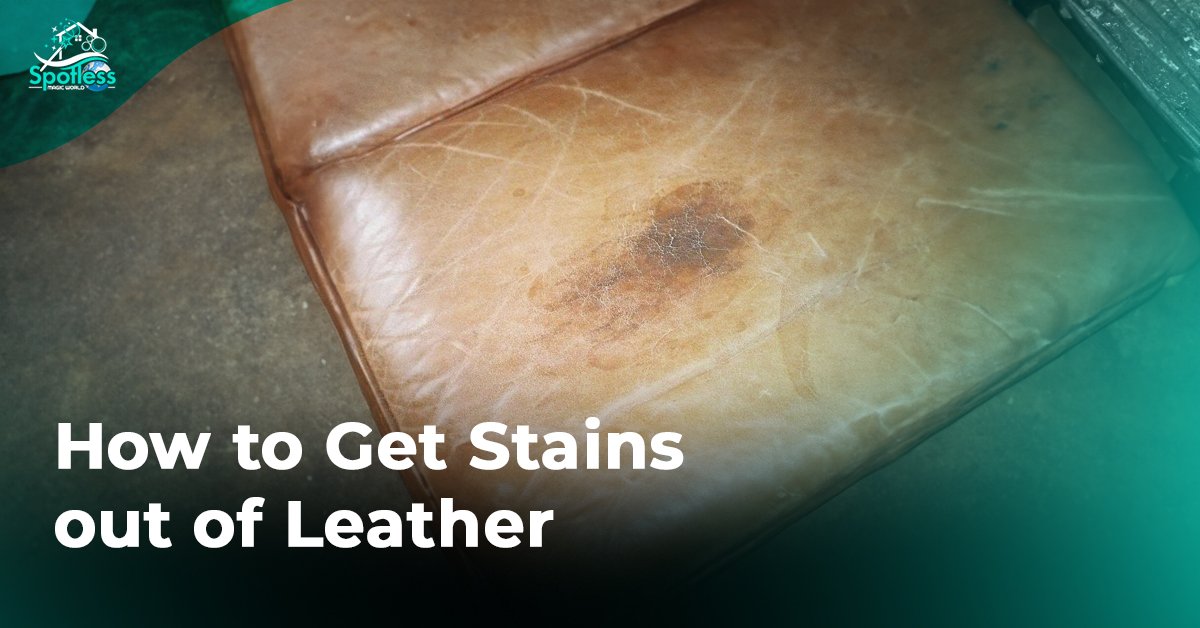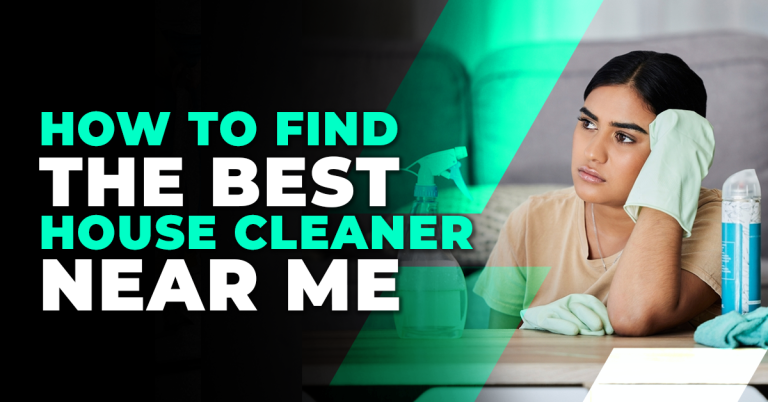Licensed And Insured

How to Get Stains out of Leather
Leather is a timeless and luxurious material found in many household items, from furniture to clothing. While leather is durable, it’s prone to stains that can be challenging to remove without damaging the material. Whether you’re dealing with ink spills, watermarks, or oil stains, knowing how to get stains out of leather safely is essential to maintain its appearance and longevity.
In this blog, we’ll explore effective methods for leather stain removal, how to care for your leather surfaces, and preventative steps to keep your leather in pristine condition.
How to Get Stains out of Leather
Numerous things, such as spilled food, water, ink, and oil, can leave stains on leather. Depending on the finish and quality of the leather, different stains react differently with it. For instance, water stains may leave behind ugly patches when the liquid evaporates, while oil-based stains can swiftly seep into leather and leave behind enduring scars. On leather surfaces, ink can also spread quickly, particularly on unfinished or untreated leather.
It’s essential to understand that not all leather is the same—there are different types such as full-grain, top-grain, and bonded leather, each requiring a unique approach to cleaning. Using incorrect cleaning products or methods can actually make the stain worse or cause irreversible damage to the leather, such as discoloration, cracking, or weakening of the material.
To avoid any mishaps, it’s always a good idea to test any cleaning solution on a less visible section of the leather first. This allows you to check if the product will cause any adverse reactions, such as fading or drying out the leather, before applying it to the stained area. This precaution helps ensure that you can clean the stain effectively without compromising the leather’s quality or appearance.
Types of Leather Stains
Leather is susceptible to various types of stains, each requiring a tailored approach for effective removal. Below are some of the most common types of leather stains and how to handle them:
- Oil and Grease Stains: These stains are especially common on leather furniture, jackets, and bags. Whether from body oils, food spills, or greasy hands, oil can seep into leather quickly due to its porous nature. Once absorbed, the oil often darkens the affected area, creating noticeable spots that can be difficult to remove. To tackle oil or grease stains, it’s important to act fast and use absorbent materials such as cornstarch or talcum powder to lift the oil before it settles deeply into the leather.
- Water Stains: While leather is often treated to be water-resistant, untreated or lightly finished leather can absorb moisture, leading to watermarks. These stains occur when water evaporates from the surface, leaving behind mineral deposits or discoloration. Water stains are particularly visible on lighter-colored leathers and can make the surface appear blotchy. To remove them, it’s important to carefully blot the area with a damp cloth to prevent further water absorption, followed by drying the surface evenly.
- Ink Stains: Ink is one of the most challenging stains to address, especially if it’s on untreated or aniline leather, which absorbs liquids more readily. Ink from pens, markers, or even makeup can quickly penetrate the leather’s surface, leaving behind vivid, often permanent marks. Light-colored leather, such as white or beige, is especially prone to permanent damage from ink stains. Immediate action is key with ink—rubbing alcohol or specialized ink removers may help, but only if applied promptly.
- Food and Beverage Stains: Spills from drinks like coffee, wine, or food sauces can be highly problematic if they soak into the leather. Liquids like wine or coffee, especially when they are acidic, can leave deep stains that are hard to eliminate. The sugars and dyes in these spills also contribute to permanent discoloration if not cleaned quickly. It’s essential to blot up any spills immediately and then treat the area with a mild soap solution or a leather cleaner designed to remove food-related stains.
Stain Removal Methods for Leather
Removing stains from leather requires careful attention to both the type of stain and the condition of the leather itself. Using the wrong method can lead to permanent damage, discoloration, or drying out the leather. Here are some tried-and-tested stain removal methods for different types of stains:
- Oil and Grease Stains: Oil and grease are common culprits, especially on leather couches, bags, and clothing. Since leather is porous, oil can be absorbed quickly, making it tough to remove once it has settled. The key to dealing with oil stains is to act fast.
- Method: First, gently blot the area with a soft cloth to soak up any excess oil. Avoid rubbing, as this can push the oil deeper into the leather. Next, apply cornstarch or talcum powder to the stain and let it sit for several hours or overnight. These powders work by absorbing the oil from the leather. After letting it sit, gently brush off the powder using a soft brush. You can then follow up with a leather cleaner to remove any remaining residue.
- Water Stains: Contrary to what some might think, water can leave noticeable marks on leather surfaces if not addressed properly. These marks are more common on untreated or unfinished leather.
- Method: Start by lightly dampening a clean cloth and gently dabbing the stained area. The goal is to slightly moisten the area around the stain to blend the watermark with the rest of the leather. Avoid soaking the leather. After blotting, let the leather dry naturally in a cool place, away from direct sunlight or heat, which can cause cracking. For stubborn water stains, you may need to use a leather conditioner to restore the moisture balance and even out the appearance.
- Ink Stains: Ink stains can be particularly stubborn and tricky, especially if left untreated. These stains often occur from ballpoint pens, markers, or even makeup products.
- Method: Begin by testing any cleaning solution on an inconspicuous area of the leather to ensure it won’t cause further damage. For ink stains, a cotton swab dipped in rubbing alcohol can be effective. Gently dab (don’t rub) the stain with the swab, being cautious not to spread the ink further. Once the ink starts to lift, use a leather conditioner afterward to rehydrate the area, as alcohol can dry out the leather.
- Food and Beverage Stains: Spills from wine, coffee, sauces, and other food items can stain leather, especially if they are not cleaned immediately. These stains can leave behind unsightly marks and, in some cases, affect the color of the leather.
- Method: Blot the spill as soon as it happens using a clean, dry cloth. For food stains, you can create a gentle cleaning solution with mild dish soap and warm water. Lightly dip a soft cloth into the solution and blot the stained area, ensuring not to soak the leather. Once the stain is removed, wipe the area with a clean, damp cloth to remove any soap residue. Finish by allowing the leather to air-dry naturally, and apply a leather conditioner to keep it supple.
- General Dirt and Grime: Leather surfaces, especially frequently used items like sofas and car seats, can accumulate dirt and grime over time.
- Method: Regular cleaning with a specialized leather cleaner is the best approach for general dirt. Apply the cleaner with a soft cloth and gently rub it in a circular motion, focusing on areas with visible dirt buildup. Avoid using too much water, as it can damage leather. Once cleaned, dry the leather using a soft towel and apply a leather conditioner to keep the leather hydrated and prevent cracking.
Preventive Measures
Prevention is key when it comes to keeping your leather surfaces looking their best. Here are some preventive measures to minimize the chances of getting stains on leather items:
- Use Protective Sprays: Apply a leather protectant spray to create a barrier against water, oil, and dirt. These sprays are especially helpful for leather couches, shoes, and bags.
- Regular Dusting and Cleaning: Wipe down your leather surfaces regularly with a dry cloth to remove dust and debris. Regular maintenance can prevent build-up that leads to stains.
- Avoid Direct Sunlight and Heat: Exposure to sunlight and heat can cause leather to dry out and become more susceptible to stains and discoloration.
- Immediate Action: The faster you address a stain, the better the outcome. Allowing a stain to set can make it harder to remove, especially on leather.
Important Tips for Safe Leather Cleaning:
- Always test first: Before applying any cleaning solution, test it on a hidden area of the leather to ensure it doesn’t cause any discoloration or damage.
- Avoid harsh chemicals: Stay away from bleach, ammonia, or other harsh cleaners that can strip the natural oils from leather, leaving it dry and cracked.
- Blot, don’t rub: When removing stains, always blot the area instead of rubbing it. Rubbing can spread the stain or damage the leather’s surface.
- Condition regularly: After cleaning, apply a leather conditioner to maintain the leather’s softness and protect it from future damage.
Stain Removal Recommendations
There are several specialized leather cleaning products on the market to help with specific stain types. Some well-reviewed options include:
- Leather Cleaner Kits: These kits typically include a gentle cleaner and conditioner, designed to remove stains and refresh the leather.
- Ink Removal Pens: Specifically made for ink stains, these pens are easy to use and effective in removing stubborn ink marks without damaging the leather.
- Leather Wipes: Convenient for on-the-go cleaning, these pre-moistened wipes are great for quick stain removal and general cleaning.
If you’re ever in doubt or dealing with a particularly stubborn stain, it’s wise to seek professional leather cleaning services. Leather experts can remove tough stains while ensuring your leather’s integrity remains intact.
Extra Support for Your Cleaning Journey
If you’re unsure of how to clean leather safely, there are plenty of resources available to guide you. Many leather furniture manufacturers provide specific care instructions for their products, including recommended cleaners. Additionally, online communities and forums dedicated to leather care offer valuable tips and advice from fellow leather owners.
For stains that are too challenging to handle on your own, professional leather cleaning services, like those offered by Spotless Magic World, can provide expert help. Our team uses specialized techniques and tools to ensure your leather looks as good as new, without the risk of damage. Whether it’s tough stains or routine maintenance, we’re here to help you keep your leather items in top condition.
Bottom Line
Leather is an investment, and maintaining its longevity and beauty requires regular maintenance. You can preserve the immaculate appearance of your leather surfaces for many years to come by knowing how to remove stains from leather and performing routine maintenance.
To protect your leather, always take prompt action when stains appear, use the appropriate treatments, and take preventative steps. Your leather furniture will continue to be a stylish and useful addition to your house or closet with proper maintenance.



